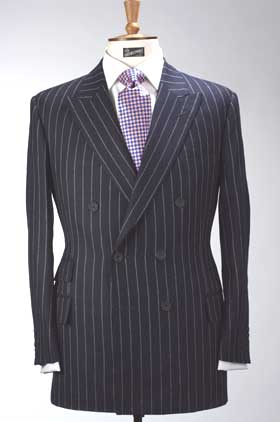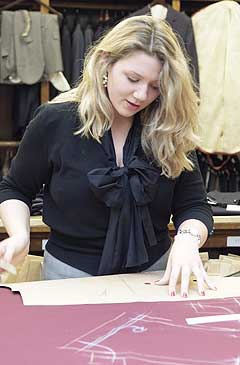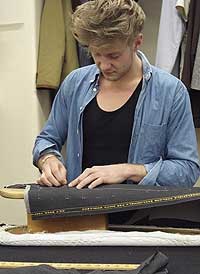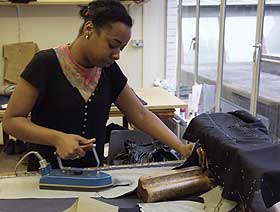|
BESPOKE TRAINING SECURES SAVILE ROW
A fashion designer may spring into the limelight of success barely touched by the hard disciplines of the workroom. Indeed, some have been decidedly sniffy about technical considerations, seeing such as interfering with their creativity.
Not so the bespoke tailor, the real McCoy Savile Row bespoke tailor, who will have spent years learning the craft, diligently  applying himself, and herself, to the practical fundamentals that go into making the best of suits. applying himself, and herself, to the practical fundamentals that go into making the best of suits.
There is no short cut here. Tailors have to have the basic skills and then the understanding and finally, for really good tailors, the flair for turning a standard garment into something special.
But in recent years, the old practices of apprenticeships and training programmes have declined, not just in Savile Row but across the board of British industry. And as the Row itself contracted, with smaller premises and fewer facilities, training up the next generation of bespoke tailors looked increasingly problematic.
This is the level of perfection that a Savile Row trainee must strive to achieve - a db suit from Henry Poole with a rope stripe.
The good news is that Savile Row now has so many young applicants eager to be  taken on that it cannot possible accommodate them all. And after years of disparate efforts with government bodies and working with colleges, it now has its own training programme that will see its first presentation of diplomas this Summer. taken on that it cannot possible accommodate them all. And after years of disparate efforts with government bodies and working with colleges, it now has its own training programme that will see its first presentation of diplomas this Summer.
“Training had to come back to Savile Row,” said Philip Parker of Henry Poole, one of the key movers in effecting such a change. “The government system just didn’t work with small companies or organisations. There was no funding.”
So when the association, Savile Row Bespoke, was set up in 2001 to help protect the Row against developers, training also came within its remit. Trainees employed by members of SRB, which includes the major names, are all eligible for a diploma at the end of a 36 month course, a diploma that will be a recognised seal of tailoring excellence anywhere in the world.
Three trainees at Huntsman, above, Pippa May, apprentice cutter; below, Christopher Bull, apprentice coat maker; below, Dionne Reeves, apprentice coat maker.
Once upon a time, most tailors would learn their craft from being a general dogsbody upwards. From running errards, through  sorting the trimmings, carrying the linings, watching the cutters, helping with fittings, up and onward, they came to know every aspect of the business. sorting the trimmings, carrying the linings, watching the cutters, helping with fittings, up and onward, they came to know every aspect of the business.
“That’s how I started,” explained Philip Parker, now managing director of the august Henry Poole. And he believes that this gave a thorough grounding that stands him in good stead. But new faster methods are called for now, and the training programme that SRB offers provides for a concentration upon a chosen area of tailoring, to fit within the 36 month course. So a trainee may choose to specialise in trousers, waistcoats, coats, or cutting.
Currently, there are some 30 trainees in the process, and 10 will receive diplomas at a ceremony to be staged at the Merchant Taylor’s Hall in July. That may not seem a great number but given that there are just 9 tailoring establishments providing the training, which is time consuming and places extra stress on already busy workers, it is quite enough for them to cope with.
“They are assessed along the way by the participating tailors,” Philip explained. “So Patrick Murphy of Huntsman and John Hitchcock of Anderson & Sheppard may call in to us, and we will go to see the  work of their trainees. work of their trainees.
“These are real apprenticeships, that will ensure the trainees acquire the tailoring skills in their chosen area to a Savile Row standard. "
In addition to the diploma trainees, SRB members continue to work with Newham College, the only one to provide a tailoring course. This means that a number of students rotate around the tailors on work placement, spending a few weeks at each, receiving a valuable insight into the Savile Row world - but one that will not result in a SRB Diploma. That is only for Savile Row employees.
What this all means for the customers of Savile Row - and those simply glad to know that this area of British excellence is still there - is that the skills and service which have been built up over so many years are being safely transferred to a new, young generation of dedicated tailors.
Noone, after all, could go through this long and arduous process, with limited remuneration, in pursuit of a diploma without really being dedicated to the craft. And so the Savile Row tradition goes on.
|